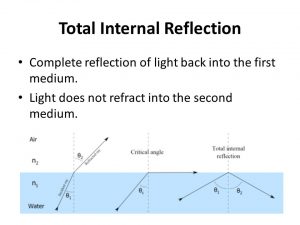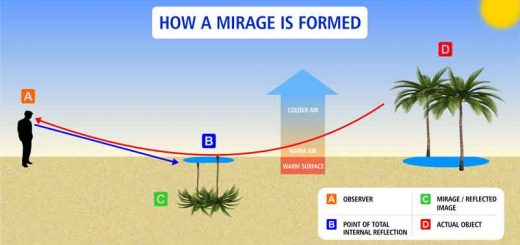The critical angle and the total internal reflection
The critical angle
The critical angle is the angle of incidence of a light ray which travels from high optical dense medium to the lower one which results in it being refracted at 90 degrees to the normal.
When the angle of refraction in the least optical dense medium (the air) is 90 degree (the refracted ray is tangent to the interface) the angle of the incidence in the most optical dense medium (the water) is called the critical angle of this medium (which differs from one medium to another).
When the light ray is incident in more optical dense medium with an angle greater than the critical angle of that medium, it reflects in the same medium which is known as the total internal reflection.
The total internal reflection is the return of a light ray when it is incident in a medium of larger optical dense by an angle larger than the critical angle of this medium.
When the light ray travels from a transparent medium of lower optical density (like the air or the water) to another of higher optical density (like the glass), it refracts near the normal, where the angle of incidence is greater than the angle of refraction.
The angle of incidence is the angle between the incident light ray and the normal at the point of incidence on the interface, while the angle of refraction is the angle between the refracted light ray and the normal at the point of incidence on the interface.
The angle of emergence is the angle between the emergent light ray and the normal at the point of emergence on the interface, and the light refraction phenomenon occurs when the light ray travels from a transparent medium to another transparent medium of different optical density.
When a light ray travels from a transparent medium of higher optical density (like the glass) to another of lower optical density (like the air), it refracts far from the normal, where the angle of incidence is less than the angle of refraction.
When the light ray falls perpendicular to the interface between two different transparent media it passes to the other medium without refraction, where the angle of incidence, in this case, equals zero.
The amount of refraction due to the transfer of a light ray from a medium to another depends on the optical density of each medium which is the ratio between the velocity of light through the air to the velocity of light through another transparent medium.
If the refractive index of a medium is high, this means that its optical density is high and vice versa, the absolute refractive index of any transparent medium is always greater than one as the velocity of light through the air is always greater than that through any other transparent medium.
The ratio between the absolute refractive index of a medium to the absolute refractive index of another medium is known as the relative refractive index.
Properties of light interference and light diffraction
The regular reflection and irregular reflection of light














